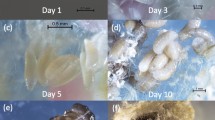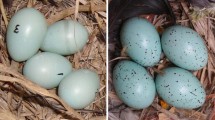Abstract
A trap-nesting study provided the first documentation of brood parasitism in Dipogon nagasei and in D. iwatai. Dipogon nagasei was found to brood parasitize D. sperconsus, D. conspersus, D. inconspersus, and D. bifasciatus. Dipogon iwatai brood parasitized D. sperconsus, D. conspersus, D. romankovae, and Auplopus carbonarius. Both brood parasitic species are with the subgenus Nipponodipogon, whereas all five Dipogon hosts are in the subgenus Deuteragenia. Comparison of their ecological features revealed that brood parasitism in D. nagasei is considerably more derived than in D. iwatai. Of particular note is the fact that in D. nagasei the female routinely lays up to five eggs on a single host spider, all of which develop into adult wasps without larval cannibalism; almost all Pompilidae previously studied lay only one egg on a host spider.





Similar content being viewed by others
References
Danks HV (1970) Biology of some stem-nesting aculeate Hymenoptera. Trans R Ent Soc Lond 122:323–399
Day MC (1988) Spider wasps. Hymenoptera: Pompilidae. Handbk Ident Br Insects 6:1–60
Endo A, Endo T (1993) Kinship structure and reproductive success in a population of the spider wasp Batozonellus lacerticida Pallas (Hymenoptera, Pompilidae). In: Jaeman PJ, Rossiter A (eds) Animal societies. Individuals, interactions and organisation. Kyoto University Press, Kyoto, pp 105–117
Evans HE (1953) Comparative ethology and the systematics of spider wasps. Syst Zool 2:155–172
Evans HE (1974) A review of the species of Dipogon occurring in Central America, Mexico, and extreme southwestern United States (Hymenoptera, Pompilidae). Trans Am Ent Soc 100:29–51
Evans HE, Matthews RW (1973) Behavioural observations on some Australian spider wasps (Hymenoptera: Pompilidae). Trans R Ent Soc Lond 125:45–55
Evans HE, O’Neill KM (2007) The sand wasps. Natural history and behavior. Harvard University Press, Cambridge (Massachusetts), London (England)
Evans HE, Shimizu A (1996) The evolution of nest building and communal nesting in Ageniellini (Insecta: Hymenoptera: Pompilidae). J Nat Hist 30:1633–1648
Evans HE, West Eberhard MJ (1970) The wasps. The University of Michigan Press, Ann Arbor
Evans HE, Yoshimoto CM (1962) The ecology and nesting behavior of the Pompilidae (Hymenoptera) of the northeastern United States. Misc Publs Ent Soc Am 3:65–119
Evans HE, Lin CS, Yoshimoto CM (1953) A biological study of Anoplius apiculatus autumnalis (Banks) and its parasite, Evagetes mohave (Banks) (Hymenoptera, Pompilidae). J N Y Ent Soc 61:61–78
Field J (1992) Intraspecific parasitism as an alternative reproductive tactic in nest-building wasps and bees. Biol Rev 67:79–126
Gess FW (1981) Some aspects of an ethological study of the aculeate wasps and the bees of a karroid area in the vicinity of Grahamstown, South Africa. Ann Cape Prov Mus Nat Hist 14:1–80
Grandi G (1954) Contributi alla conoscenza degli Imenotteri Aculeati XXVI. Boll Ist Ent Univ Bologna 20:81–255
Gros E (1983) Note sur la biologie de quelques Pompilides (2e partie) (1). Entomologiste 39:24–35
Harris AC (1987) Pompilidae (Insecta: Hymenoptera). Fauna of New Zealand. No. 12. Department of Scientific and Industrial Research, Science Information Publishing, Wellington
Harris AC (1999) The life histories and nesting behaviour of the Pompilidae (Hymenoptera) in New Zealand: a comparative study. Species Diversity 4:143–235
Hashimoto Y, Endo T (1994) A comparison of tube-renting wasp and bee richness (Hymenoptera) among the new town area, urban area and rural area of Sanda City: study on the evaluation of natural conditions in the local environment using the trap-nest technique. Humans and Nature 4:63–70, in Japanese
Haupt H (1927) Monographie der Psammocharidae (Pompilidae), Mittel-, Nord- und Osteuropas. Dt Ent Z 1926–1927:1–367
Ishikawa R (1965) A preliminary revision of the Japanese species of the genus Dipogon Fox (I) (Hymenoptera, Pompilidae). Mushi 38:87–100, pls. 7–8
Ishikawa R (1968) On two species of the genus Dipogon (Hymenoptera, Pompilidae) from Rikuchu Province, Iwate Prefecture. Mem Natn Sci Mus 1:115–116
Iwata K (1975) From the field notes of a naturalist. The Asahi Shimbun, Tokyo, in Japanese
Iwata K (1976) Evolution of instinct. Comparative ethology of Hymenoptera. Amerind Publishing, New Delhi, English translation of ‘Honnô no shinka’, 1971
Iwata K (1980) Observations on insect life for 50 years (IV). The Asahi Shimbun, Tokyo, in Japanese
Krombein KV (1955) Miscellaneous prey records of solitary wasps I. (Hymenoptera: Aculeata). Bull Brooklyn Ent Soc 50:13–17
Krombein KV (1967) Trap-nesting wasps and bees: life histories, nests and associates. Smithsonian Institute Press, Washington DC
Krombein KV, Hurd PD, Smith DR, Burks BD (1979) Catalog of Hymenoptera in America north of Mexico, vol. 3, indexes. Smithsonian Institution Press, Washington, DC
Lane MA, Kurczewski FE, Hanna RB (1988) Antennal sensilla and setae of Evagetes parvus (Hymenoptera: Pompilidae). Proc Ent Soc Wash 90:428–439
Lelej AS (1986) Spider wasps of genera Dipogon Fox and Poecilageniella Ishikawa (Hymenoptera, Pompilidae) of the Far East. Revue Ent URSS 65: 799–808, in Russian
Lelej AS (1995) [Superfam. Pompiloidea.] In: Lehr PA (ed) [Key to the insects of Russian Far East in six volumes. Vol. 4. Neuropteroidea, Mecoptera, Hymenoptera. Part 1.] Nauka, St. Petersburg, pp 211–264, in Russian
Matsumoto K, Makino S (2011) Monitoring of tube-nesting bees and wasps with bamboo tube nest traps of different types in two types of forests in temperate Japan. Ent Sci 14:1–8
O’Neill KM (2001) Solitary wasps: behavior and natural history. Comstock, Ithaca
Olberg G (1959) Das Verhalten der solitären Wespen Mitteleuropas (Vespidae, Pompilidae, Sphecidae). Deutscher Verlag der Wissenschaften, Berlin
Pitts JP, Wasbauer MS, von Dohlen CD (2006) Preliminary morphological analysis of relationships between the spider wasp subfamilies (Hymenoptera: Pompilidae): revising an old problem. Zoologica Scripta 35:63–84
Richards OW, Hamm AH (1939) The biology of the British Pompilidae (Hymenoptera). Trans Soc Br Ent 6:51–114
Shaw MR (1997) Two Dipogon subintermedius (Magretti) (Hym.: Pompilidae) apparently developing on one spider. Entomologist’s Rec 109:244
Shimizu A (1986) A new species of Auplopus from Japan, with notes on some basic characters in the taxonomy of the genus (Hymenoptera, Pompilidae). Kontyû 54:54–69
Shimizu A (1994) Phylogeny and classification of the family Pompilidae (Hymenoptera). Tokyo Metro Univ Bull Nat Hist 2:1–142
Shimizu A (2000) Cleptoparasitic behavior and flagellar sensilla of Poecilagenia sculpturata (Hymenoptera: Pompilidae). Ent Sci 3:499–510
Shimizu A, Ishikawa R (2002) Taxonomic studies on the Pompilidae occurring in Japan north of the Ryukyus: genus Dipogon, subgenus Deuteragenia (Hymenoptera) (Part 1). Ent Sci 5:219–235
Shimizu A, Wasbauer M, Takami Y (2010) Phylogeny and the evolution of nesting behaviour in the tribe Ageniellini (Insecta: Hymenoptera: Pompilidae). Zool J Linn Soc 160:88–117
Tsuneki K (1946) The Japanese hunting wasps. Their ecology and psychology. Hoppo Shuppan-sha, Sapporo, in Japanese
Wasbauer MS (1995) Pompilidae. In: Hanson PE, Gauld ID (eds) The Hymenoptera of Costa Rica. Oxford University Press, Oxford, pp 522–539
Wcislo WT, West-Eberhard MJ, Eberhard WG (1988) Natural history and behavior of a primitively social wasp, Auplopus semialatus, and its parasite, Irenangelus eberhardi (Hymenoptera: Pompilidae). J Insect Behav 1:247–260
Weaving AJS (1994) Notes on nesting behaviour in two Afrotropical auplopine wasps, Auplopus vitripennis Smith and A. femoralis (Arnold) (Hymenoptera: Pompilidae). Entomologist 113:140–153
Williams FX (1919) Philippine wasp studies. Bull Hawaiian Sug Plrs’ Ass Exp Stn Ent Ser 14:1–186
Acknowledgements
We thank A. C. Harris (Otago Museum, New Zealand) and Professor K. Goukon (Tohoku Gakuin University) for reviewing the manuscript with critical comments and Emeritus Professor R. Ishikawa (Tokyo Metropolitan University) for providing specimens and suggestions. For the help in installing trap nests, our thanks are also due to the following: A. Nakanishi, Y. Hashimoto, Y. Hirayama, H. Sakata, R. Shindome, H. Ueda, H. Umeda, K. Matsumoto, and many students of Animal Ecology Laboratory, Kobe College. Thanks also to D. Cohen (Otago University, New Zealand) for her help in proofreading and editing.
Author information
Authors and Affiliations
Corresponding author
Rights and permissions
About this article
Cite this article
Shimizu, A., Nishimoto, Y., Makino, S. et al. Brood Parasitism in Two Species of Spider Wasps (Hymenoptera: Pompilidae, Dipogon), with Notes on a Novel Reproductive Strategy. J Insect Behav 25, 375–391 (2012). https://doi.org/10.1007/s10905-011-9298-0
Revised:
Accepted:
Published:
Issue Date:
DOI: https://doi.org/10.1007/s10905-011-9298-0




